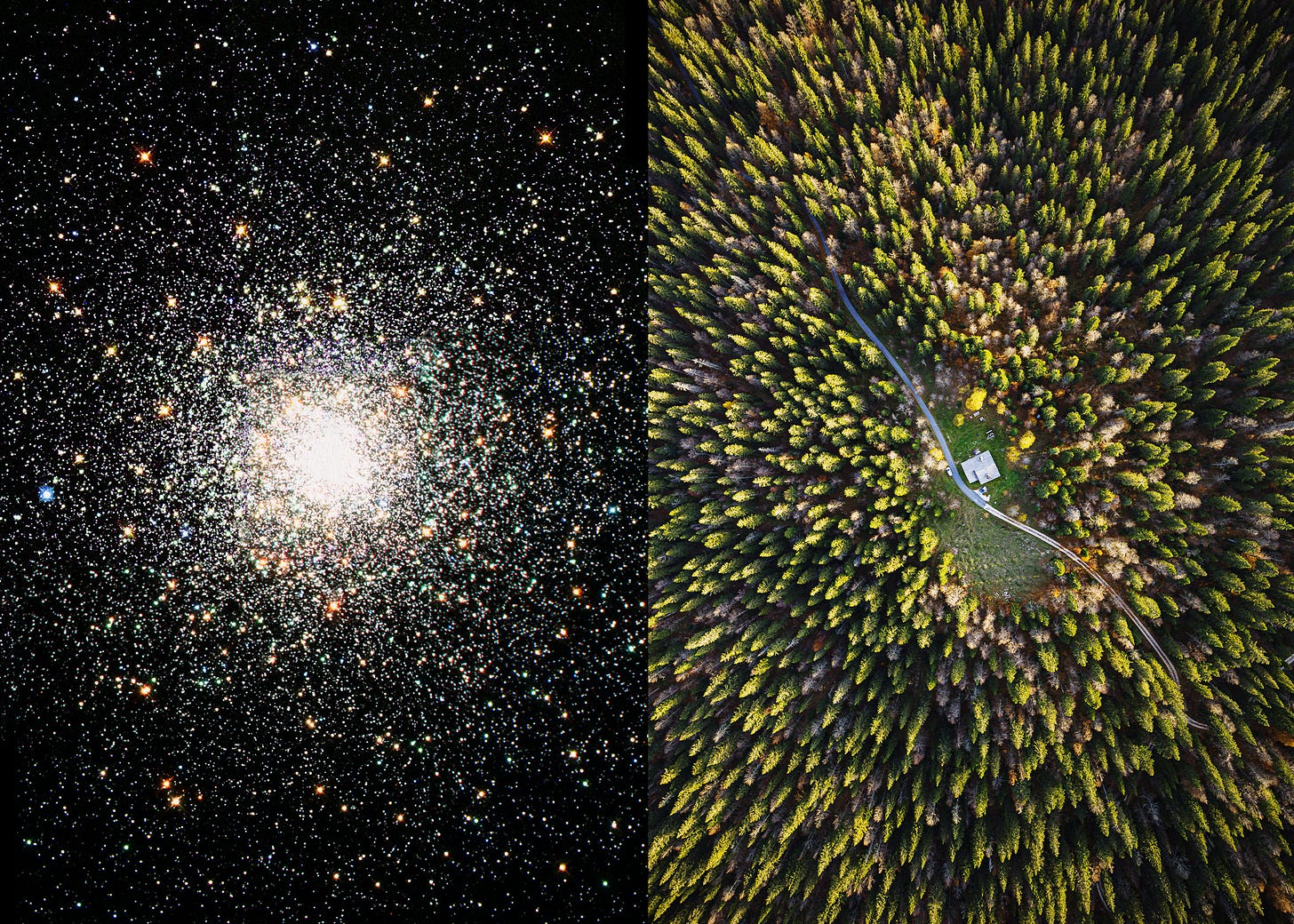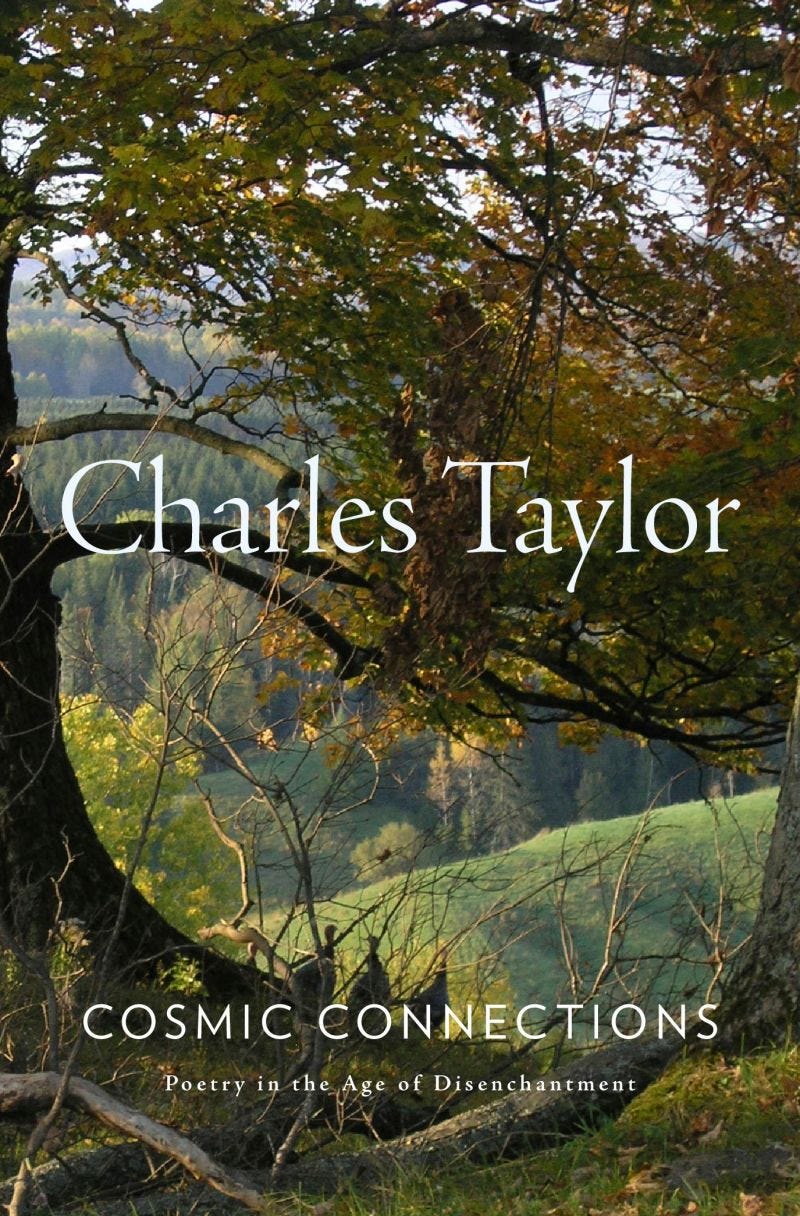Lost in the Forest of Symbols
Charles Taylor’s big-hearted, misshapen book on philosophy, poetry, and our never-ending quest to heal the wound of modern alienation.
Cosmic Connections
Poetry in the Age of Disenchantment
by Charles Taylor
Belknap, 640 pp., $37.95
AMONG A SMALL BUT VOCAL SUBSET of readers, the arrival of a new doorstopper on poetry and philosophy by Canadian thinker Charles Taylor is liable to induce swooning.
For at least fifteen years, other thinkers have been describing him as an “elder statesman” of English-speaking philosophy, and his broadly synthesizing, historically detailed arguments in works such as Sources of the Self and A Secular Age have become touchstones on some of the great themes of modern thought: language, political identity, religion and secularism, selfhood, and the notions of authenticity and representation in multicultural democracies. Taylor’s work stands alongside that of the most abstruse and forbidding continental theorists. But his own style is lucid (if longwinded), and his insights are accessible to anyone willing to put in a bit of old-fashioned intellectual labor.
Cosmic Connections sits at the confluence of a number of streams that flow through Taylor’s intellectual project: It offers a historical and philosophical examination of Romanticism, focusing especially on the role of disenchantment in the era’s poetry. The book, however, is not simply a historical study. Taylor’s investigations of Romanticism stem from his desire to understand—and, ultimately, to recommend—the Romantics’ particular strategy for addressing “the human need for cosmic connection.” While he has gestured at and digressed into this territory many times in prior works, this is the book in which he maps it out.
The Romantics understood, along with their intellectual predecessors in the Enlightenment, that the new capabilities and social forms of the nascent modern world seemed to require the dismantling of the imaginative architecture of premodern life. But unlike most Enlightenment thinkers, they felt keenly the desolation such advances wrought, and they gave systematic articulation to their resulting sense of loss. Modernity, they knew, was irreversible, even if it came at a heavy cost; and they had no desire to turn back the clock in any case. In this context, art in general and poetry in particular had to reflect the changes of the past two centuries, but it also had to productively inhabit the ambivalence brought on by those changes and the new sense of alienation from nature that accompanied them. The work of the poet was no longer to read a universally recognized meaning off the world but to forge, in Taylor’s words, an “interspace”—a “locus of potentially transforming experience” that links cosmic meaning to personal expression. Construed in this way, poetry is both a record of the writer’s encounter with the world and a place of encounter for the reader. Even more, the poem itself is the encounter.
Poetry thus becomes “epiphanic”—a “forest of symbols,” in Baudelaire’s famous phrase, whose meaning is now fungible. Symbols are less representational, loosened from their moorings to a fixed set of significations. They evoke moods and emotions and polyvalent images, not encoded, predetermined meanings. One person might, to use one of Taylor’s favored examples, read Wordsworth’s “motion and spirit” that “rolls through all things” in “Tintern Abbey” as an impersonal, pantheistic life force, while another might read it as the presence of the trinitarian God in creation (as Wordsworth himself came to do later in life). But both readers could still derive meaning from it, could still be moved by it in the same, or at least analogous ways.
Here is how Taylor himself sums up the developments I have been describing:
The Romantic poets . . . reacted to the fading of solidly accepted metaphysico-moral cosmic orders with a sense of loss. They sought to recover contact with a deeper order in things. In this they were inspired by the earlier notions of order but were aware that they couldn’t recover them through a clear theoretical vision. Their response was to attempt to recover contact through “symbols,” which offered “translations” of this deeper order. But the orders to which they felt reconnected were in the nature of things defined in fragmentary and incomplete fashion, accessed as they were through the constitutive semantic logic of the symbol.
While Taylor characterizes this embrace of symbol and “loosening” of cosmic meaning as “epistemic retreat,” he argues that it does not entail a slide into subjectivism. The seventeenth-century rationalist Descartes and his intellectual successors may have cordoned “objective,” scientific knowledge off from “subjective,” psychological knowledge, but the Romantics wanted neither to set back the clock nor to justify their project within the confines of Enlightenment rationality. They sought, rather, fundamentally new forms of knowledge. For the poets and writers Taylor focuses on—and for those who followed them, in different ways—great art holds a certain epistemic force all its own, and its power is not purely subjective. We can’t deny the force of Beethoven’s Fifth Symphony, that it calls us to a higher, better life, even if the specificity of that calling is unclear.
THIS IS, MORE OR LESS, THE ARGUMENT of part one, which comprises roughly the first hundred pages of Cosmic Connections. But apart from a few additions and qualifiers, some of them admittedly important, the argument stops there. The remainder of the book—parts two through six—functions as a set of extended close readings of the poets Taylor takes to exemplify the unfolding of these developments over the past two centuries.
Taylor lavishes gobs of loving, detailed attention on these poets, from Hölderlin all the way to Miłosz. (Pride of place goes to Baudelaire and Mallarmé, if page count is any indicator, with Hopkins, Rilke, Eliot, and Miłosz each meriting his own chapter.) Along the way, he reproduces long excerpts of their poetry, often providing the original lines alongside English translations. He clearly has a deep love of his material.
But does it hold up as a book?
I have a hunch that poetry-curious philosophers and theologians will find Taylor’s work here exciting and informative, and that philosophy-curious poets and literary scholars will find it tedious and unenlightening. I land somewhere in between. Like many readers who have appreciated Taylor’s philosophical forays into literature over the years, I was exhilarated by his extended meditations on literary converts at the conclusion of A Secular Age (2008). These figures drove home Taylor’s thesis to me: They broke out of the “immanent frame” of workaday secular life into a broader, fuller experience of reality, not by escaping the supposed confines of modernity but by finding portals to meaning and transcendence within it. The prospect of a book-length study of this development in modern poetics that traces its roots back to Romanticism seemed to me, and to other readers of Taylor, to hold much promise.
Yet for all his evident affection for the poetry he discusses in Cosmic Connections, Taylor is at his best when he is on his home turf of philosophy. The middle four hundred pages of the book are, frankly, a bit of a mess. Quotations are strung together almost like catenae. His prose, always loose and conversational, becomes occasionally so cursory and fragmented it feels like notes rather than criticism. And despite the luminosity of so much of the poetry under discussion, the central chapters are heavy on exegesis and short on synthesis. The argument sags. One comes away wondering whether Taylor got so caught up admiring the trees he became lost in the forest of symbols.
As a result, no real, coherent philosophical-historical narrative ever emerges out of these close readings. At most, we may say that Taylor traces a shift in cosmological orientation from the first Romantic poets in the 1790s all the way to Eliot and Miłosz in the twentieth century. As the nineteenth century progresses, cosmic connection comes to be associated not with a perennial force or presence pervading the cosmos (as with Wordsworth or Hölderlin) but with a sense of “higher time” or “gathered time” punctuating an otherwise mundane existence. This shift becomes especially clear with Baudelaire, and it finds its culmination in Eliot.
It’s an interesting-enough insight, but a meager payoff following four hundred pages of analysis. Typically when reading Taylor, one gains a thick sense of the intricate, highly ramified character of his arguments’ conclusions; they arrive with momentum. But in this case, the heavy lifting has already been done in A Secular Age. As a result, this book feels somewhat derivative—like a coda, if a six-hundred-page book can be a coda.
PERHAPS, THOUGH, THERE IS A DEEPER philosophical point at work. Taylor’s aim is not merely to illustrate that certain philosophical trends can be seen in this or that poem, this or that poet. He is arguing that post-Romantic poetry inaugurates a new way of “knowing”—that it gives us true knowledge in a form distinct from rational, Cartesian, scientific, “objective” knowledge. It does this not by describing reality but by staging a personal encounter with it.
To “describe” this effect, he must re-create the experience of the poems that give rise to it. In that sense, no amount of critical analysis will do. Taylor must expose us to the field of force (Taylor’s phrase) at work in the poetry itself that allows both poet and reader to reconnect with the enchanted cosmos. From the perspective of this goal, Taylor may have doomed the book by not writing the whole thing in verse. (Of course, this would have doomed it in a different way.) However, what he has done—creating a context for that exposure in the first hundred pages before dropping the reader into a sea of spiritually resonant poetry—is instructive even in its failure.
Near the end, speaking of Eliot’s poem “Little Gidding” in Four Quartets (though he could be speaking of any of the works explored in this volume), Taylor says that poetry “calls for a new language. It calls on us to find the sense, the inner direction of the prayers of those who came before us, and to find a new formulation.” It’s a startling assertion for a work of philosophical poetics. That Taylor may here be concluding his remarkable life’s work—he is ninety-two, after all—with a long meditation on the nature of poetry seems a fitting philosophical gesture, an indication that his philosophy finds its final, maturest form in a struggle to articulate something close to prayer.
“It is poetry, not philosophy,” he writes in a gloss on Miłosz, “which can tell the deep truth of our age.” Philosophy fails us, but by necessity. For it is at the moment philosophy collapses in on itself into silence that poetry says what philosophy cannot. The Romantics would have agreed.
Without his ever stating that this is the case, the book feels very personal to Taylor. It is a plea for the legitimacy of what he has found most moving, most nourishing, over the long decades of his life: The longing to create art and to encounter it and to discover meaning in it, whether it takes the form of a symphony by Beethoven or a landscape by Pissarro or a sonnet by Rilke. And his working theory seems to be that he has found in the poetics of cosmic connection a deep sense of significance, and he wants for us to find it too. Despite the different underlying stories, the endlessly diverging and never resolving meanings and symbols and significations, he finds that poetry still calls to him, still makes claims on him that are definite in their effect if not in their propositional content.
Why should that be the case, for him or for anyone else? What is it that keeps drawing us back to these wells? This book is his answer.





